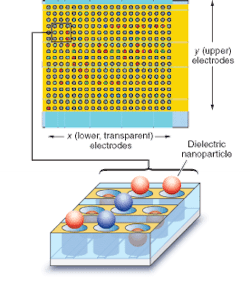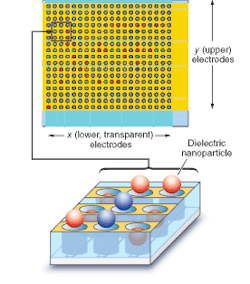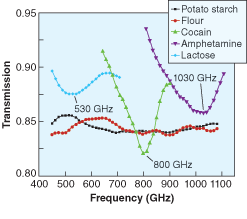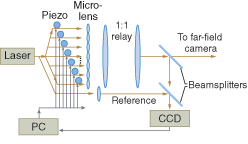CONFERENCE PREVIEW: Nano, defense, and fiber stand out at CLEO 2006
Annual conference will feature a wide variety of technical advances, as well as business-related talks on funding and market opportunities for photonics.
Hassaun A. Jones-Bey
Several themes stand out in the program of next month’s CLEO/QELS conference (www.cleoconference.org) to be held from May 21 to 26 at the Long Beach Convention Center (Long Beach, CA). Quantum phenomena and nanophotonics, technology for defense and security, and fiber lasers are three of these themes, with quantum phenomena and nanotechnology (the subject of one plenary talk, two special symposia, and numerous research presentations) being arguably the most prominent.
During a Wednesday (May 24) morning plenary session, Richart E. Slusher of Lucent Technologies will look into the future of quantum optical repeaters that may eventually enable quantum teleportation, distributed quantum computing, and high-security quantum channels over a global quantum Internet. Of two special symposia at the conference, one is a QELS symposium on nonlinear nanophotonics. The other is a CLEO/QELS symposium on enabling technologies for quantum communication.
Also on Wednesday, researchers from Cornell University (Ithaca, NY) will discuss the development of “electroactive” nanowells to exploit extremely localized electrokinetic effects to guide and confine nanoparticles into targeted nanostructures (CWL1). Potential applications include sensing and optofluidically adaptable photonics (see Fig. 1).
On Thursday May 25, researchers from the Naval Research Laboratory and Case Western Reserve University (Cleveland, OH) will describe how nanolayered polymer films were used to construct materials whose properties mimic bio-optic systems found in nature (CThI2). The nanolayered structures have a unique ability to control the index-gradient profile in three dimensions. Such bio-inspired optical polymers offer a fundamentally new way to make lenses that have a refractive gradient index instead of a curve across the surface allowing much thinner layers. Potential applications include the development of unmanned aerial vehicles (UAVs).
On Friday May 26, presenters of two papers will discuss progress in the use of attosecond pulses. David Villeneuve from the Research Council of Canada will discuss how high-harmonic generation from aligned gas-phase molecules can form an image of a single molecular orbital wave function (JFB1). Researchers in the Henry Kapteyn and Margaret Murnane group at JILA (Boulder, CO) will describe one of the first observations of intramolecular dynamics using high-order harmonic generation (JFB2). They impulsively excite vibrations in sulfur hexafluoride and observe oscillations in the intensity of high-order harmonic emission from the molecules.
Defense and security
A second prominent theme at CLEO 2006 is defense and security, particularly in terms of market opportunities and research funding. During a Monday (May 22) evening plenary session,Robert F. Leheny, deputy director of the Defense Advanced Research Projects Agency, will discuss emerging applications in defense systems for emerging optoelectronic technologies. In addition, a major portion of the business program will focus on defense and security issues.
Business-related talks on funding opportunities include “Third Generation Infrared Sensors” by Joe Pellegrino of the U.S. Army Night Vision Lab;“Counter-MANPADS (Man-Portable Air Defense Systems) Overview and Status” by Kerry Wilson, Department of Homeland Security; and “ChemBio Sensors: Strategies and Issues for National Defense” by Ngai Wong of the Defense Threat Reduction Agency (DTRA). David Krohn from Light Wave Venture Consulting (Hamden, CT) will give an invited talk “Photonics Sensor Market Potential in Homeland Security Applications.” And Ruth Woodward of HT Consultants (Oxford, England) will present “Terahertz Sources and Detectors for Homeland Security.”
Also on Monday, researchers from Picometrix (Ann Arbor, MI) will report on the application of a transmission and reflection reconfigurable large-area time-domain terahertz imager to homeland security and nondestructive evaluation (CMLL1). Later in the same symposium researchers from National Taiwan University and National Central University (Taiwan, China) will demonstrate the ability to identify illicit drug powders using a terahertz-biochip (CMLL7) integrated with a compact high-efficiency microterahertz source with tunable terahertz frequencies for direct, sensitive, localized label-free biosensing (see Fig. 2).
On Tuesday, May 23, researchers from MIT (Cambridge, MA) and Sandia National Laboratories (Albuquerque, NM) will report the high-power demonstration of quantum-cascade lasers at approximately 4.4 THz that emit 248‑mW peak power in pulsed mode, and 138-mW continuous-wave power at heat-sink temperatures of 10 K (CTuT2). In the following presentation (CTuT3), researchers from the Vienna University of Technology (Vienna, Austria) and the Semiconductor Physics Institute (Vilnius, Lithuania) will describe microdisk terahertz quantum-cascade lasers with diameters reduced to less than the free-air emission wavelength and compare the measurement results with 3-D finite-difference time-domain simulations. This paper highlights a new avenue of combining terahertz with microdisk lasers that exhibits very low loss.
Fiber lasers and more
In the Monday evening plenary session David Payne from the University of Southampton (Southampton, England) will highlight a third major theme, the coming generation of fiber lasers. At kilowatt levels, fiber lasers have already had a substantial impact on markets for laser marking, cutting, and welding, and exciting prospects for beam combination, visible sources, MW pulsed, and other novel configurations are anticipated.
On Thursday, researchers from MIT Lincoln Lab (Lexington, MA) will report coherent combining of 32 polarization-maintaining fibers and demonstrate for the first time coherent combining of multiple fiber lasers (CThAA6). The use of a 2-D fiber array as the beam former makes this approach scalable to more than 1000 fibers (see Fig. 3). Also on Thursday (CThJ1), another research team will describe the use of a picosecond single-mode, linearly polarized fiber source that produces 175 W of average power to generate up to 80-W average power at 530 nm by frequency doubling through a single LBO crystal.
Numerous other themes not covered in plenary sessions, but arguably just as prominent as those mentioned thus far include high-field science, biomedical applications, silicon photonics, and photonic crystals, to name just a few. Presentations in a joint CLEO/QELS symposium on high-field science will include a description on Tuesday by researchers from Osaka University (Osaka, Japan) of ongoing construction and experimental plans for their 10-kJ petawatt laser, currently the most powerful in the world (JTuG1).
On Wednesday in the same joint symposium, researchers from the University of Michigan (Ann Arbor, MI) and Oak Ridge National Laboratory (Oak Ridge, TN) will discuss particle accelerators based on lasers (JWC1). And on Thursday, researchers from Friedrich Schiller University (Jena, Germany), University of Strathclyde (Glasgow, Scotland), and JAERI (Kyoto, Japan) will report the first production of quasi-monoenergetic proton beams using laser plasmas, which places laser plasma acceleration within the scope of medical applications (JThA2).
Among medical applications, OCT will be a prominent topic. On Monday, MIT researchers will discuss the use of Fourier-domain modelocking for ultrahigh-speed biomedical OCT imaging (CMZ2). On Tuesday University of Washington (Seattle, WA) researchers will report a method for improving the accuracy in determining blood flow rate and small vessel size by implementing a delay line filter when processing real-time spectral domain OCT images of flow (CTuW2). Also in an unusual but potentially widespread application Tuesday, researchers from EA Photonics (Redondo Beach, CA) and the University of California (Irvine, CA) will discuss the use of spatial-frequency-domain imaging (SFDI) to perform quality assessment of apples (CTu02).
Silicon optics and holey fiber
On Wednesday researchers from Moscow State University (Moscow, Russia) will discuss the recent initial observation of current-induced second-harmonic generation in silicon (QWF1). Also on Wednesday a presentation will discuss the use of reverse-biased p-i-n diode structure to efficiently reduce nonlinear absorption and achieve continuous-wave lasing in silicon waveguide cavities based on stimulated Raman scattering (CWD1).
On the topic of photonic crystals, a presentation on Monday will describe high-power (46 mW), single-lobed, surface-emitting operation in a 2-D photonic-crystal laser by optimizing the structure of the lattice points, under room temperature, continuous-wave conditions, which shows that it is possible to achieve high-power light in a defined mode (CMKK1). A paper on Tuesday will showcase a 3-D-2-D-3-D photonic crystal, directly written with a laser (CTuAA1). And a paper on Thursday will describe the study of super-collimation in a planar 2-D photonic crystal at 1.5-µm wavelengths and observed an inherent robustness to short-scale disorder (CThK4). A 2-µm-wide beam was propagated over more than 0.5 cm without diffraction.❏



